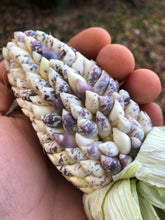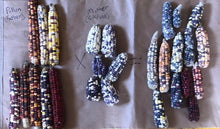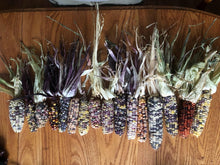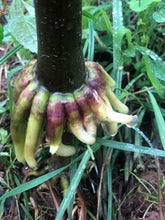'Speckled Parching' Self-Feeding Corn Grex
Regular price
$6.00
Sale
Zea mays subsp. mays
Origin: Peru & Mexico, via Asheville, North Carolina
Improvement status: Landrace
Seeds per packet: ~80
Germination tested 12/2022: 60%
Life cycle: Annual
We could not be more excited to be offering these seeds (and three other related populations) in the catalog for the first time: corn that produces mucilage from its roots which attracts nitrogen-fixing bacteria, effectively supplementing their nitrogen needs and allowing the plants to basically feed themselves!
Legumes are the most famous nitrogen-fixing plants, well-known as excellent soil-improvers for use in rotations, as companion plants, or as cover-crops. But it's not actually the plants that do the work. Nitrogen-fixing — converting atmospheric nitrogen into natural fertilizer — typically happens in small underground structures called "root nodules" where symbiotic bacteria live and use an enzyme called nitrogenase to break down nitrogen from the air. While most legumes are nitrogen-fixers, a few non-leguminous plants have evolved in relationship with bacteria to provide for their own nitrogen needs. These include phacelia (borage family), alder trees (beech family), bayberry (myrica family), sea buckthorn (elaeagnus family), and New Jersey tea (buckthorn family). In recent years, scientists have begun noticing similar (though less widespread) symbiotic relationships between important crop plants and nitrogen-fixing bacteria, including sugarcane, wheat, rice, and corn.
The most well-known mucilaginous corn comes from the Mixe people of Oaxaca, Mexico. A variety called 'Olotón' has been subject of intense study, including by scientists with the University of California - Davis, the University of Wisconin, and Mars, Incorporated, the global food conglomerate. You can read about its history and the controversy surrounding the exclusive, confidential licensing agreement between the massive corporation and Totontepec, the small Mixe town where the corn is found (along with other towns in the region, extending as far away as Guatemala). Unsurprisingly, the farmers there have long recognized the importance of the sticky goo dripping off their corn plants — so much so that they collect it and apply it to the roots of other plants.
https://e360.yale.edu/features/indigenous-maize-who-owns-the-rights-to-mexicos-wonder-plant
Flying under the radar, there are quite a few Andean corn varieties from South America that have the same mucilage-producing trait — and it's likely quite a few others do as well (we've even seen mucilaginous aerial roots in corn's African cousin sorghum!). Some of these corns, like 'Cuzco Gigante' and 'Maiz Morado', are commonly available as food in Latin American markets around the world. But the challenge for corn growers in the US and elsewhere is that these varieties are adapted to high altitudes much closer to the equator, so their daylength sensitivity makes it very difficult if not impossible to grow them to maturity in most of the US (they only begin flowering in the fall and then they get killed by frost).
Mike Fortune is an Asheville-based grower with a passion for corn. In 2005, he founded Green Hill Urban Farm as both a local source for sustainably-grown produce and a community center for co-learning and co-production on multiple lots behind Rocky's Hot Chicken Shack on Patton Avenue. Around a decade ago, Mike was invited to attend the Mistura Festival in Lima, Peru, the largest annual food event in South America, by Chef Hector Diaz (whose farm Mike was managing at the time). It was there he learned about high-altitude Andean corns — and first witnessed this special trait that indigenous farmers have been well aware of for countless generations, but which today's scientists and agronomists are only just beginning to understand: nitrogen-fixing bacteria in relationship with corn root exudates. Mike is not the only person who has worked hard to adapt these corns to the north — Munk Bergin spent decades working with 'Maiz Morado' before releasing his northern-adapted 'Soltera Morado' — but to our knowledge, he's the only US researcher unaffiliated with a large institution to have focused so much of his attention on the nitrogen-fixing trait.
Nitrogen fertilizer is a major source of carbon pollution (from its industrial production), nitrous oxide pollution (an even more potent greenhouse gas than CO2, released as fertilizer degrades), aquatic ecosystem pollution (excess nitrogen leads to hazardous algal blooms and dead zones), and nitrate pollution in drinking water (harmful to human health). Since corn fertilized with nitrogen is such a massive part of our current agricultural system, with many deleterious effects, there is an urgent need to develop alternatives that are better for the environment. Self-feeding corn is one such alternative. But in order for it to reach its potential, it must not be used to further the domination of multinational corporations like Mars, but instead must be used for the benefit of all — and especially for the people whose ancestors first nurtured the mucilage-producing corn and who continue cultivating it today.
We are grateful Mike came to us (recommended by the Utopian Seed Project in Asheville) to begin releasing his experimental corn lines to the wider world. We're also grateful that he's willing to do so in a thoughtful and ethical manner. As the breeder of this corn, normally Mike would receive 50% of the proceeds of every packet sold, but instead he intends to donate his share to an organization in the Peruvian Andes that supports traditional agriculturalists. We will donate half of what would normally come to EFN to the same organization, so a total of 75% of the price of every packet sold goes back to Andean farmers. Additionally, we are releasing this corn with a special Material Transfer Agreement similar to the Open Source Seed Initiative Pledge (see below). It stipulates that anyone purchasing these seeds agrees to never patent them or their derivatives, nor to pass on the seeds to anyone else without the same agreement in place. Your purchase of these seeds binds you to this agreement. We further urge that all future growers of these seeds or their derivatives implement fair and equitable benefit sharing with the indigenous communities involved in their development.
This year we have small amounts of four populations of Mike's self-feeding corn strains, each of which includes Andean corns pollinated by North American corns (including 'Painted Mountain', 'Kentucky Rainbow', 'Bloody Butcher', and "Oaxacan" Green Dent; along with some Mexican corns and others), and then backcrossed to Andean types again. The 'Speckled Parching' line includes the beautiful 'Pisccoruntu' variety from Peru, and has been selected to be most similar to that, but still contains a high degree of diversity. The 'Asheville Morado' line includes the most and deepest purple corns, which are used in the Andes to make the beloved purple beverage called "Chicha Morada." The 'Gigante Hominy' line includes a number of "gigante" types from Peru (many of which came to Mike via corn researcher Stephen Smith). And the 'Ultracross' line contains all of the above and more.
Mike wrote us this explaining in more detail what's in these populations:
The purpose of releasing these now, while they are still highly diverse experimental lines, is to encourage more breeding, selection, and adaptation work and speed up the process of getting self-feeding corn widely grown. Growers interested in this corn have a choice: you can wait a decade or more to buy self-feeding corn from Mars, Inc., and then rely exclusively on Mars for your future self-feeding corn seed needs, or you can start working with these seeds now, saving seeds only from the best plants and selecting for corns that suit your purpose. But more broadly, we are releasing these now in an effort to prevent corporations from attempting to patent self-feeding corn and thus restrict others from growing something that has the potential to change the world for the better in incalculable ways.
LEGAL AGREEMENT: These seeds ("the germplasm") and their derivatives are available for food production, research, training and breeding purposes. No recipient can claim ownership over the germplasm or obtain Intellectual Property Rights on it or related information. Recipients may reproduce the material and distribute it to other parties provided they also are willing to accept the conditions of this Material Transfer Agreement. The recipient's retention of the material constitutes such acceptance. In other words, by purchasing these special seeds, you agree to never patent or otherwise restrict the use of this germplasm or its descendants. This germplasm represents the work of generations of indigenous farmers across two continents, in countless communities, along with the work of generations of non-indigenous farmers, and thus it should forever remain in the public domain.
NOTE: Due to the scarcity of these seeds, customers are limited to 1 packet of each type. (Please do not order more than 1 packet of each. Doing so creates more work for us as we'll need to manually change your order and refund you for the extra packets you pay for.)








